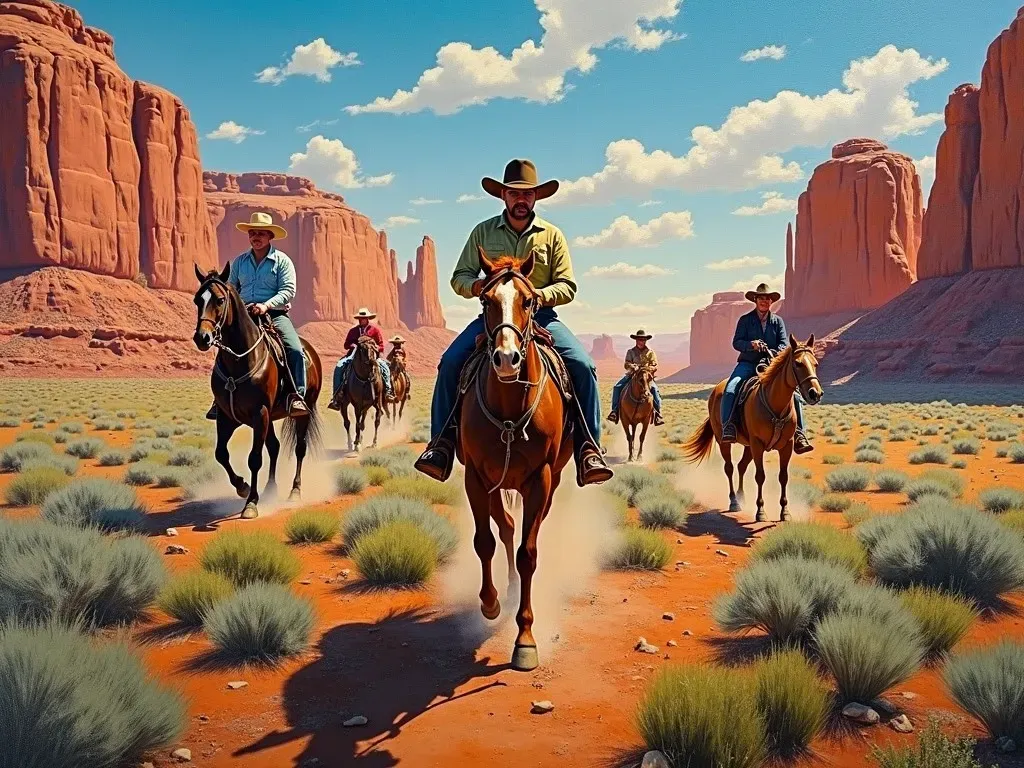Famous Western art is a captivating exploration of the American frontier, encompassing various stylistic genres and historical events captured on canvas. This genre of art not only celebrates the rugged landscapes and the rich culture of the West but also immortalizes the characters who roamed its vast territories. From stunning landscapes to iconic cowboy depictions, the world of famous Western art paintings reflects the spirit of adventure, heroism, and the struggle for identity in a rapidly changing world.
Famous Western Art: A Celebration of the Spirit of the West
Famous Western art includes works from artists who aimed to depict the life, people, and scenery of America’s western territories. This genre is characterized by a variety of styles and themes, from realism to romanticism, and features subjects such as cowboys, Native Americans, and expansive, untouched landscapes. Some standout pieces include Frederic Remington’s depictions of cowboy life, Charles Marion Russell’s charming portrayals of Native American culture, and Albert Bierstadt’s dramatic landscapes of the American West.
Key Artists in Famous Western Art
| Artist | Notable Works | Style | Period |
|---|---|---|---|
| Frederic Remington | "The Bronco Buster", "The Outlaw" | Realism | 1861-1909 |
| Charles Marion Russell | "When the Land Belonged to God" | Romanticism | 1864-1926 |
| Albert Bierstadt | "Among the Sierra Nevada Mountains" | Luminism | 1830-1902 |
| Thomas Hart Benton | "The Sources of Country Music" | Regionalism | 1889-1975 |
Iconic Paintings in Western Art
The narrative of famous Western art is also filled with iconic paintings that continue to resonate with audiences today. Here are some essential works that every art lover should know:
-
"The Ox Team" by Charles Marion Russell
- A classic depiction of early American migration that captures the struggle and determination of settlers.
-
"The Last of the Buffalo" by Albert Bierstadt
- A poignant reminder of the rapid changes in the West and the impact of human activity on nature.
-
"The Signal" by Frederic Remington
- An action-filled scene showing the communication between cowboys, emphasizing the thrill of life on the frontier.
-
"Mr. and Mrs. Robert L. McCulloch" by Thomas Hart Benton
- A unique portrait that incorporates elements of Western storytelling and mythology in a contemporary context.
Thematic Elements of Famous Western Art
Famous Western art is layered with thematic elements that often reflect the complexities of the American experience:
-
Adventure and Exploration: Many artworks celebrate the adventure of exploring unknown territories and the beauty of rugged landscapes.
-
Cultural Representation: Artists often focused on representing the lives of Native Americans and settlers, highlighting the cultural exchanges that occurred.
-
The Cowboy Mythos: This genre glorifies cowboys, symbolizing freedom and individualism. The portrayal often blends romanticism with the harsh realities of frontier life.
-
Nature and the Environment: Landscapes play a vital role in Western art, depicting vast plains, mountains, and valleys, often serving as a backdrop to human struggles and triumphs.
Famous Western Artists: Evolution and Influence
The movement of famous Western art saw artists evolve over time, capturing the transformation of the West. Their works not only highlighted societal changes but also influenced future generations of artists.
-
Frederic Remington: Known as the foremost chronicler of the American West, Remington’s art has been deemed instrumental in establishing the cowboy culture in popular imagination. His works often appeared in magazines and reflected a romanticized view of the West.
-
Charles Marion Russell: Often referred to as "The Cowboy Artist," Russell depicted Native American culture and the lives of cowboys with authenticity and empathy. His works not only inspired artists but also educated the public about the realities of frontier life.
-
Albert Bierstadt: As a leading American landscape painter, Bierstadt’s dramatic renditions of the West allowed viewers to appreciate its grandeur. His style solidified the idea of America as a land of beauty and opportunity.
Frequently Asked Questions (FAQ)
What defines Western art?
Western art is characterized by its focus on the landscapes, people, and events associated with the American West, including elements of realism, romanticism, and landscape painting.
Who are some of the most famous Western artists?
Some of the most recognized Western artists include Frederic Remington, Charles Marion Russell, and Albert Bierstadt.
What are the common themes in famous Western art?
Common themes in famous Western art include adventure and exploration, cultural representation, the glorification of cowboy life, and the depiction of nature and the environment.
Where can I view famous Western art?
You can view famous Western art at various museums such as the National Cowboy & Western Heritage Museum Visit Here or galleries featuring American Western art.
Are there modern interpretations of Western art?
Yes, contemporary artists continue to explore the themes of Western art, often incorporating modern perspectives on identity, culture, and the environment.
Conclusion
Famous Western art presents a unique lens through which to view American history, culture, and landscapes. The artists, paintings, and themes crafted within this genre reveal stories of adventure, challenge, and beauty, offering viewers a captivating look into the diverse experiences that have shaped the American West. Each piece serves as a testament to the enduring allure of the frontier spirit and the rich narrative woven into the fabric of Western art history.
